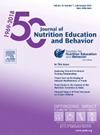Common Feeding Practices Used by Chinese Caregivers of 6–10-Month-Old Infants: A Behavioral Observation Study in Shaanxi Province
IF 2.3
3区 医学
Q2 EDUCATION, SCIENTIFIC DISCIPLINES
引用次数: 0
Abstract
Objective
To explore the feeding practices and feeding environment of Chinese families with 6–10-month-old infants.
Design
One day of caregiver-recorded feeding occasions.
Setting
Homes in Shaanxi, China.
Participants
Families recruited using convenience sampling.
Variables Measured
Videos were coded for feeding practice frequency and acceptance rate, feeding environment, and responsiveness to infant fullness cues and eating pace.
Analysis
Wilcoxon rank sum tests examined the differences in feeding practice use based on caregiver type, infant sex, and infant weight status.
Results
Twenty-eight families provided videos for coding. The most commonly observed feeding practices were opening the mouth, giving instructions, and interfering with the child's actions. Prompts to eat were accepted 86.9% of the time. Overweight infants’ caregivers used significantly more coercive prompts to eat than did caregivers of healthy-weight infants (P < 0.05). Mothers used more autonomy-supportive prompts to eat than did fathers (P < 0.05). Early, active, and late infant fullness cues were captured in 25.6%, 34.8%, and 8.5% of videos, respectively. 53.6% of caregivers fed at the right pace, whereas 14.5% and 31.9% fed too slow or too fast, respectively. Approximately 5.5% of videos had a screen on, and 33.5% of videos included at least 1 other distraction during the meal.
Conclusions and Implications
Differences in feeding practices among caregivers suggest that targeted advice may further improve feeding practices. Improving the caregiver's ability to identify satiety cues and respond to infant eating speed may also reduce the risk of overfeeding.
中国 6-10 月龄婴儿看护者的常见喂养方式:陕西省行为观察研究》。
目的探讨有6-10个月大婴儿的中国家庭的喂养方式和喂养环境:环境:中国陕西省的家庭:地点:中国陕西省的家庭:测量变量:对视频进行编码,包括喂养频率和接受率、喂养环境、对婴儿饱腹提示的反应和进食速度:Wilcoxon秩和检验根据照料者类型、婴儿性别和婴儿体重状况检验喂养方法使用的差异:结果:28 个家庭提供了用于编码的视频。最常见的喂养方法是张开嘴、发出指令和干扰孩子的动作。86.9%的婴儿接受了进食的提示。体重超标婴儿的看护人使用的强迫性进食提示明显多于体重健康婴儿的看护人(P < 0.05)。母亲对进食的自主支持性提示多于父亲(P < 0.05)。分别有 25.6%、34.8% 和 8.5% 的视频捕捉到了婴儿早期、活跃期和晚期的饱腹提示。53.6%的照顾者喂奶速度合适,而14.5%和31.9%的照顾者喂奶速度过慢或过快。约有 5.5% 的视频开着屏幕,33.5% 的视频在进餐过程中至少有一次分散了注意力:护理人员在喂养方式上的差异表明,有针对性的建议可进一步改善喂养方式。提高护理人员识别饱腹感提示和应对婴儿进食速度的能力也可降低过度喂养的风险。
本文章由计算机程序翻译,如有差异,请以英文原文为准。
求助全文
约1分钟内获得全文
求助全文
来源期刊
CiteScore
4.20
自引率
11.50%
发文量
379
审稿时长
44 days
期刊介绍:
The Journal of Nutrition Education and Behavior (JNEB), the official journal of the Society for Nutrition Education and Behavior, is a refereed, scientific periodical that serves as a global resource for all professionals with an interest in nutrition education; nutrition and physical activity behavior theories and intervention outcomes; complementary and alternative medicine related to nutrition behaviors; food environment; food, nutrition, and physical activity communication strategies including technology; nutrition-related economics; food safety education; and scholarship of learning related to these areas.
The purpose of JNEB is to document and disseminate original research and emerging issues and practices relevant to these areas worldwide. The Journal of Nutrition Education and Behavior welcomes evidence-based manuscripts that provide new insights and useful findings related to nutrition education research, practice and policy. The content areas of JNEB reflect the diverse interests in nutrition and physical activity related to public health, nutritional sciences, education, behavioral economics, family and consumer sciences, and eHealth, including the interests of community-based nutrition-practitioners. As the Society''s official journal, JNEB also includes policy statements, issue perspectives, position papers, and member communications.

 求助内容:
求助内容: 应助结果提醒方式:
应助结果提醒方式:


